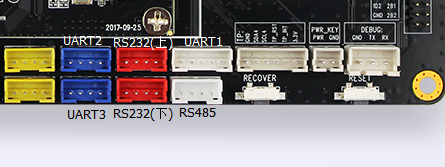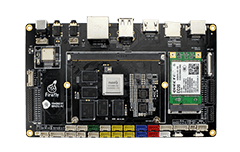9. UART Use¶
9.1. Introduction¶
AIO-3288J support SPI bridge/expansion of four enhanced functions of the serial port (UART), respectively UART2, RS232 (above), RS485, UART3 and three master comes with serial ports, respectively, UART1, RS232(below) Debug serial port. Each UART has a 256-byte FIFO buffer for data reception and transmission. among them:
UART1 ~ UART3 are TTL level interface, RS232 is RS232 level interface, RS485 is RS485 level interface
Each sub-channel UART baud rate, word length, parity format can be set independently, up to 2Mbps communication rate
Each sub-channel has a receive/send independent 256 BYTE FIFO, FIFO interrupt can be programmed according to user needs Trigger point
With sub-serial port receive FIFO timeout interrupt
Support for start bit error detection detailed locations .
AIO-3288J development board serial interface interface as follows:

9.2. Configuration Steps¶
The spi to uart node have already been created in file kernel/arch/arm/boot/dts/firefly-rk3288-aio-3288j.dts, Enable this node to use it:
&spi0 {
status = "okay";
max-freq = <48000000>;
spidev@00 {
status = "disabled";
compatible = "linux,spidev";
reg = <0x00>;
spi-max-frequency = <48000000>;
};
spi_wk2xxx: spi_wk2xxx@00{
status = "okay";
compatible = "firefly,spi-wk2xxx";
reg = <0x00>;
spi-max-frequency = <10000000>;
reset-gpio = <&gpio0 GPIO_C2 GPIO_ACTIVE_HIGH>;
irq-gpio = <&gpio0 GPIO_A7 IRQ_TYPE_EDGE_FALLING>;
cs-gpio = <&gpio5 GPIO_B5 GPIO_ACTIVE_HIGH>;
pwr-en-gpio = <&gpio3 GPIO_B6 GPIO_ACTIVE_HIGH>;
};
};
9.3. Debug method¶
The kernel has enabled these serial ports in default, the software nodes corresponding to hardware interface are:
RS485:/dev/ttysWK3
RS232(above):/dev/ttysWK1
RS232(below):/dev/ttyS3
UART1:/dev/ttyS1
UART2:/dev/ttysWK0
UART3:/dev/ttysWK2
The user can use different USB to serial port adapters of the host computer to transmit/receive data to/from the serial port of development board according to different ports, for example, the debugging steps of RS485 are as follows:
9.3.1. Connect hardware¶
Connect the A, B and GND pins of RS485 on development board to the corresponding pins of serial port adapter of host computer (USB to 485 to serial port module) respectively.
9.3.2. Turn on the serial port terminal of host computer¶
Enable Kermit on the terminal and set Baud rate:
$ sudo kermit
C-Kermit> set line /dev/ttyUSB0
C-Kermit> set speed 9600
C-Kermit> set flow-control none
C-Kermit> connect
/dev/ttyUSB0is the device file of USB to serial port adapter
9.3.3. Send data¶
The device file of RS485 is /dev/ttysWK3. Run the following command on the device:
echo firefly RS485 test… > /dev/ttysWK3
The serial terminal in host computer can receive the character string “firefly RS485 test…”
9.3.4. Receive data¶
Firstly run the following command on the device:
cat /dev/ttysWK3
Then, input the character string “Firefly RS485 test…” at the serial terminal in host computer. You can see the same character string on the device.
